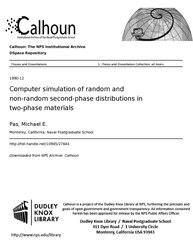File:Computer simulation of random and non-random second-phase distributions in two-phase materials (IA computersimulati1094527644).pdf

Original file (1,275 × 1,650 pixels, file size: 1.44 MB, MIME type: application/pdf, 51 pages)
Captions
Captions
Summary edit
| Computer simulation of random and non-random second-phase distributions in two-phase materials
( |
||
|---|---|---|
| Author |
Pas, Michael E. |
|
| Title |
Computer simulation of random and non-random second-phase distributions in two-phase materials |
|
| Publisher |
Monterey, California: Naval Postgraduate School |
|
| Description |
The mechanical properties of any material with a discontinuous second phase dispersed in a matrix are recognized to be influenced by the distribution of the second-phase particles. Current models for the prediction of material properties from particle distributions are based on the assumption of a random particle distribution. Through computer simulation, nearest-neighbor particle spacings have been calculated for random and non-random distributions. For low fractions, random distributions approach the theoretical spacing predicted from consideration of random, infinitesimal points. For finite sized particles, increasing fraction results in larger spacings than predicted for infinitesimal points. For very high fractions, the spacing approaches that for regular (crystalline) arrays. Also, metal matrix composites initially possess clustered particle distributions. Upon processing, such distributions can be transformed into banded distributions with areas of both high and low density. With sufficient processing, random distributions can be attained. Non-random (banded) distributions were simulated. Sufficient banding results in reduced average particle spacing. Subjects: Computer simulation; Engineering; Science.; Particle distribution; computer simulation |
|
| Language | English | |
| Publication date |
December 1990 publication_date QS:P577,+1990-12-00T00:00:00Z/10 |
|
| Current location |
IA Collections: navalpostgraduateschoollibrary; fedlink |
|
| Accession number |
computersimulati1094527644 |
|
| Source | ||
| Permission (Reusing this file) |
This publication is a work of the U.S. Government as defined in Title 17, United States Code, Section 101. As such, it is in the public domain, and under the provisions of Title 17, United States Code, Section 105, may not be copyrighted. | |
Licensing edit
| Public domainPublic domainfalsefalse |
This work is in the public domain in the United States because it is a work prepared by an officer or employee of the United States Government as part of that person’s official duties under the terms of Title 17, Chapter 1, Section 105 of the US Code.
Note: This only applies to original works of the Federal Government and not to the work of any individual U.S. state, territory, commonwealth, county, municipality, or any other subdivision. This template also does not apply to postage stamp designs published by the United States Postal Service since 1978. (See § 313.6(C)(1) of Compendium of U.S. Copyright Office Practices). It also does not apply to certain US coins; see The US Mint Terms of Use.
|
 | |
| This file has been identified as being free of known restrictions under copyright law, including all related and neighboring rights. | ||
https://creativecommons.org/publicdomain/mark/1.0/PDMCreative Commons Public Domain Mark 1.0falsefalse
File history
Click on a date/time to view the file as it appeared at that time.
| Date/Time | Thumbnail | Dimensions | User | Comment | |
|---|---|---|---|---|---|
| current | 16:12, 8 July 2020 |  | 1,275 × 1,650, 51 pages (1.44 MB) | Fæ (talk | contribs) | FEDLINK - United States Federal Collection computersimulati1094527644 (User talk:Fæ/IA books#Fork8) (batch 1990-1992 #3736) |
You cannot overwrite this file.
File usage on Commons
The following page uses this file:
Metadata
This file contains additional information such as Exif metadata which may have been added by the digital camera, scanner, or software program used to create or digitize it. If the file has been modified from its original state, some details such as the timestamp may not fully reflect those of the original file. The timestamp is only as accurate as the clock in the camera, and it may be completely wrong.
| Short title | Computer simulation of random and non-random second-phase distributions in two-phase materials |
|---|---|
| Author | Pas, Michael E. |
| Software used | Pas, Michael E. |
| Conversion program | |
| Encrypted | no |
| Page size |
|
| Version of PDF format | 1.4 |

